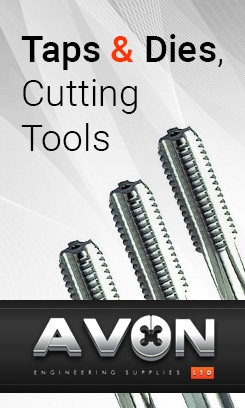Feed Speeds
Formulas for calculating tapping speeds
Tapping speeds are determined by many factors. The main ones are:
- Thread pitch
- Material being tapped
- Hole depth
- Hole type, through or blind
- Depth of thread
- Lubricant quality and flow rate
Tapping speeds can be calculated using:-
RPM = Feed speed (SFM)
0.26 x Tap OD
|
TAPPING SPEEDS SHOULD BE DECREASED IF: |
TAPPING SPEEDS CAN BE INCREASED IF: |
|---|---|
|
|
Recommended feed speeds and lubricants
Speeds given are for machine tapping using HSS taps, and are given in feet per minute.
|
MATERIAL |
FEED SPEED (SFM) |
LUBRICANT |
|---|---|---|
|
Aluminium |
70-90 |
Soluble oil |
|
Aluminium alloy |
50-70 |
Soluble, light base or lard oil |
|
Brass |
60-100 |
Light base oil |
|
Bronze |
30-40 |
Light base oil |
|
Copper |
60-80 |
Light base oil |
|
Gun metal |
50-60 |
Soluble, light base or lard oil |
|
Grey cast iron |
30-60 |
Dry or soluble oil |
|
Alloy cast iron |
15-30 |
Sulphur based oil |
|
Malleable iron |
20-40 |
Soluble or sulphur based oil |
|
Magnesium alloy |
50-70 |
Soluble oil or paraffin with lard oil |
|
Nimonic alloy |
10-12 |
Very high pressure cutting oil |
|
Plastics |
50-70 |
Dry, freeze spray, liquid soap |
|
Mild steel |
30-50 |
Sulphur based oil |
|
Carbon steel to 4% |
20-40 |
Sulphur based oil |
|
Carbon steel to 7% |
20-30 |
Sulphur based oil |
|
Carbon steel 7%+ |
15-25 |
Sulphur based oil |
|
Steel alloys to 60T |
15-25 |
Sulphur based oil |
|
Steel alloys 60T+ |
10-15 |
Sulphur based oil |
|
Stainless steels |
10-20 |
Sulphur based oil |
|
Tool steels |
15-25 |
Sulphur based oil |
Common problems and causes
With so many variables affecting tapping speeds there may need to be some experimentation to find the ideal. A good rule is to start at the slowest speed and work up.
Many factors can affect the quality of a tapped thread. Some more common problems are listed along with probable causes.
|
POOR THREAD FINISH |
OVERSIZE/BELL MOUTHED |
|---|---|
|
|
|
EXCESSIVE TAP WEAR |
COLD WELDING |
|
|
|
TAPS BREAKING |
TAP TEETH CHIPPING |
|
|
General rules for avoiding problems
In order to minimise problems the following rules should be followed:
- Use a pitch controlled tapping attachment
- Choose the correct lubricant
- Use the correct type of tap for the job
- Use the correct tapping drill size
- Choose the correct speeds and feeds
- Keep taps sharp. Regrind with a proper machine
- Ensure accurate alignment
- Check hardness of material, especially when changing batches
- Ensure thread gauging is recently certified – they do wear!


